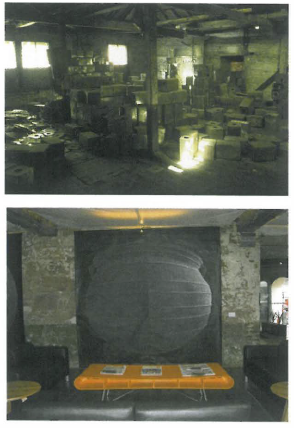
Opening on October 1, 2004, The Henry Jones Art Hotel represents a cornerstone of the redeveloped derelict historic buildings along the northern side of Hobart's Sullivans Cove. While Salamanca Place and its weekly market have captured community and tourist interest in the past 30 years, Old Wharf and Hunter Street on the opposite side of the waterway have played an equally significant role in the establishment of the city and are poised to once again sit at the forefront of Hobart life, but this time through fine art and design rather than its harsh convict past or as the transit point for immigration and trade.
The current development completes a rejuvenation process commenced in 1986 with the relocation of the Tasmanian School of Art into part of the former IXL Jam Factory, established by Australia's first international business tycoon, Henry Jones. The buildings to the west of the school were also part of the jam factory, but each had a life before jam and Henry Jones. They are amongst the oldest and most significant buildings in Hobart, having been variously a probation station, government offices, gibbet, warehouses, private homes, hotels, shops, candle and soap factory, stevedoring and fishing retail, and brothels as well as primary production export.
With encouragement from visionary architect, Robert Morris-Nunn, and recognising the importance of Hunter Street to the development of Hobart and Tasmania, an art school team investigated and interpreted the precinct's industrial, social, cultural and architectural heritage and contemporary characteristics throughout 2003 and 2004. The research resulted in a proposal to The Henry Jones Art Hotel operators that they should include art and design objects developed in response to the site, its buildings and history as defining elements within the five-star hotel.
A Google search for 'Art Hotel' reveals over 34,000 sites. Most self-proclaimed art hotels justify their 'art' claim merely by having art on their walls or in gardens, without promoting a specific theme or curatorial precept. Some of the hotels make their art claim by virtue of proximity to an art museum or gallery district. Some boast rooms designed by artists or designers, while others have changing exhibitions in hotel rooms or in an associated gallery.
Very few hotels invite artists to interpret or critique the notion of hospitality, accommodation, itinerancy or travel – the basic characteristics of a hotel. Fewer still consider the potential for artists and designers to interpret the history of the hotel's buildings, site, locale or previous functions.
Despite two decades of neglect, the Hunter Street site and its buildings are rich with the remnants of past industry and development. Many of these have been sensitively preserved and creatively incorporated within the hotel design. The school team identified factory machines, can races, enamelling kilns, hundreds of jam tins and lids; and also more personal detritus including wages receipts and graffiti. The materials from which the buildings were constructed also offer a wonderful array of textures, colours and wear and tear that is visually interesting.
The team reasoned that, given the ubiquity of art in hotels generally, the distinctiveness of the art within The Henry Jones Art Hotel will rest with its proximity to the Tasmanian School of Art and within the hotel site's rich history and potential to contribute to Tasmania's future development.
To date several creative outcomes have been accepted into the hotel. Esteemed furniture designer, Kevin Perkins advised on appropriate design solutions and materials, especially unique Tasmanian timber veneers, for furniture in hotel rooms: bed-heads, desks, TV and fridge cupboards, etc.
Furniture for transit spaces by Pippa Dickson, large drawings of industrial artefacts by Lindsay Broughton, a screenprint addressing cultural dislocation and memory by Karen Lunn and a stereoscopic photographic installation, presenting the former factory spaces immediately prior to their transformation, by Martin Walch will be presented permanently within the hotel.
An exhibition, IXL Art, presented in the Plimsoll Gallery, 27 December 2003 to 25 January 2004, as part of the state's bicentennial celebrations included 28 exhibitors who provided work that responded to the IXL factory buildings' social and industrial history. Most of the exhibiting artists and designers had work accepted for ongoing display within hotel's guest rooms, public spaces, and in the dedicated 'installation' room, an oversized guest room that doubles as an art gallery. Most work presented in the hotel is offered for sale, often in partnership with local commercial galleries.
The project's significance for the school lies in the opportunity for continuing evaluation and interpretation of Hunter Street and the structures and activities that define it. Based on the team's experience, a model for collaborative and 'real-life' projects is emerging that will allow the Tasmanian School of Art to offer an unprecedented learning opportunity that will see The Henry Jones Art Hotel as an ongoing stimulus for new art and design.












